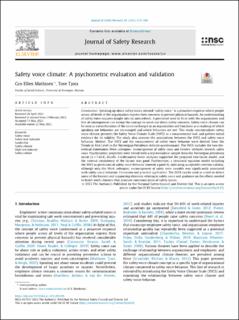| dc.contributor.author | Mathisen, Gro Ellen | |
| dc.contributor.author | Tjora, Tore | |
| dc.date.accessioned | 2023-10-24T12:37:04Z | |
| dc.date.available | 2023-10-24T12:37:04Z | |
| dc.date.created | 2023-08-10T15:22:12Z | |
| dc.date.issued | 2023-09 | |
| dc.identifier.citation | Mathisen, G.E., Tjora, T. (2023) Safety voice climate: A psychometric evaluation and validation. Journal of Safety Research, 86, 174-184 | en_US |
| dc.identifier.issn | 0022-4375 | |
| dc.identifier.uri | https://hdl.handle.net/11250/3098438 | |
| dc.description.abstract | Introduction: Speaking up about safety issues, termed “safety voice,” is a proactive response where people across all levels of the organization express their concerns to prevent physical hazards. An understanding of safety voice requires insight into its antecedents. A perceived need to fit in with the organization and fear of consequences can trump the courage to speak out about safety concerns. Safety voice climate can be seen as a manifestation of the social exchanges in an organization and functions as a roadmap of which speaking out behaviors are encouraged and which behaviors are not. This study conceptualizes safety voice climate, presents the Safety Voice Climate Scale (SVCS) as a measurement tool, and gathers initial evidence for its validity. The study also assesses the associations between the SVCS and safety voice behavior. Method: The SVCS and the measurement of safety voice behavior were derived from the Trends in Risk Level in the Norwegian Petroleum Activity questionnaire. The SVCS includes the two theoretical dimensions Work colleagues’ encouragement of safety voice and Leaders’ attitudes towards safety voice. Psychometric properties were tested with a representative sample from the Norwegian petroleum sector (n = 7,624). Results: Confirmatory factor analyses supported the proposed two-factor model, and the internal consistency of the factors was good. Furthermore, a structural equation model including the SVCS as predictors of safety voice behavior showed a good fit, indicating acceptable criterion validity, although only the Work colleagues’ encouragement of safety voice variable was significantly associated with safety voice behavior. Conclusion and practical application: The SVCS can be used as a tool to detect some of the barriers and supporting elements relating to safety voice and guidance on the efforts needed to foster work climates that promote communication of safety issues. | en_US |
| dc.language.iso | eng | en_US |
| dc.publisher | Elsevier Ltd. | en_US |
| dc.rights | Navngivelse 4.0 Internasjonal | * |
| dc.rights.uri | http://creativecommons.org/licenses/by/4.0/deed.no | * |
| dc.subject | organisasjonspsykologi | en_US |
| dc.subject | psykometri | en_US |
| dc.title | Safety voice climate: A psychometric evaluation and validation | en_US |
| dc.type | Peer reviewed | en_US |
| dc.type | Journal article | en_US |
| dc.description.version | publishedVersion | en_US |
| dc.rights.holder | © 2023 The Author(s). | en_US |
| dc.subject.nsi | VDP::Samfunnsvitenskap: 200 | en_US |
| dc.source.pagenumber | 174-184 | en_US |
| dc.source.volume | 86 | en_US |
| dc.source.journal | Journal of Safety Research | en_US |
| dc.identifier.doi | 10.1016/j.jsr.2023.05.008 | |
| dc.identifier.cristin | 2166232 | |
| cristin.ispublished | true | |
| cristin.fulltext | original | |
| cristin.qualitycode | 1 | |

